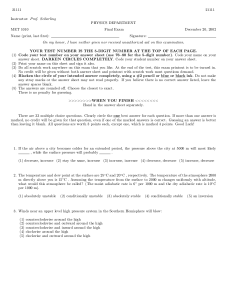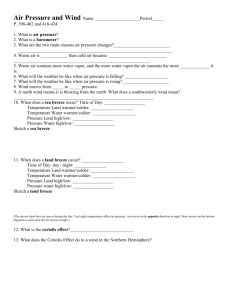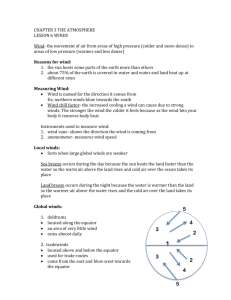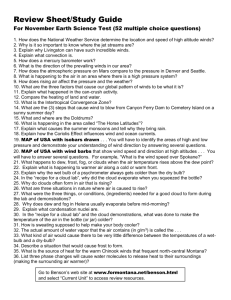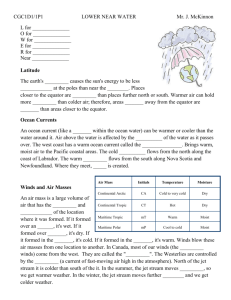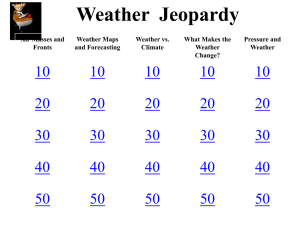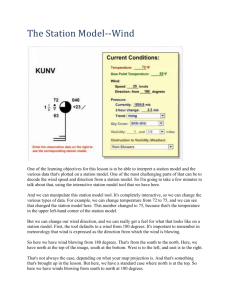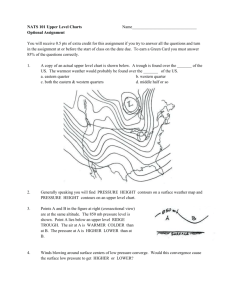51111 Instructor: Prof. Seiberling PHYSICS DEPARTMENT MET 1010
advertisement
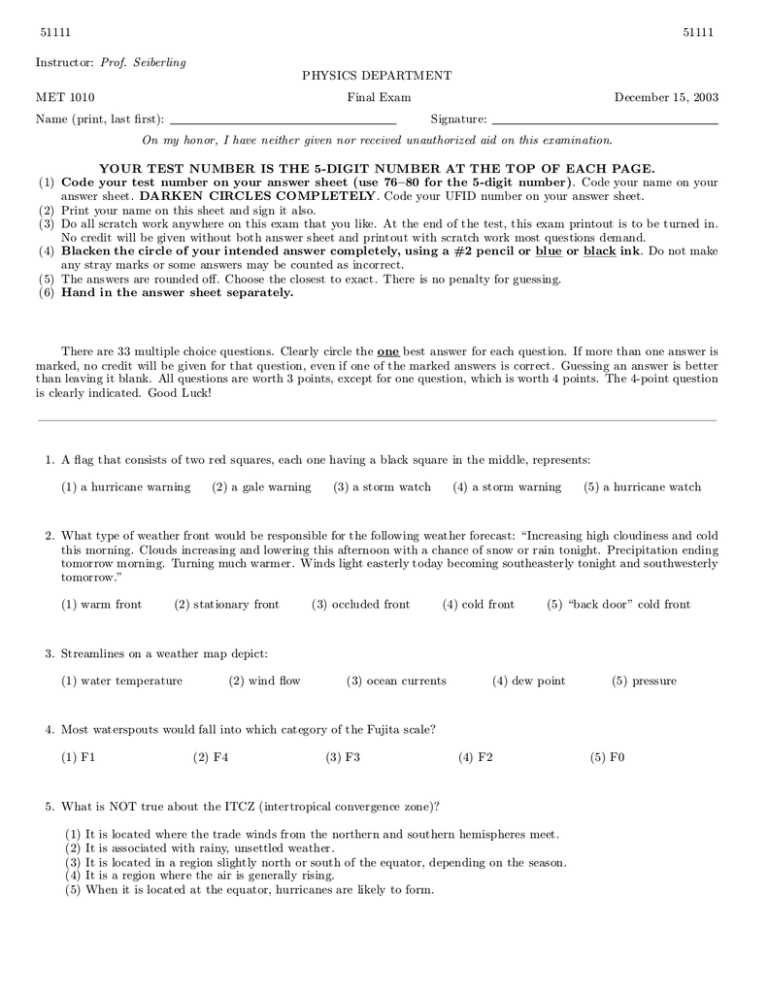
51111
51111
Instructor: Prof. Seiberling
PHYSICS DEPARTMENT
MET 1010
Final Exam
Name (print, last ¯rst):
December 15, 2003
Signature:
On my honor, I have neither given nor received unauthorized aid on this examination.
YOUR TEST NUMBER IS THE 5-DIGIT NUMBER AT THE TOP OF EACH PAGE.
(1) Code your test number on your answer sheet (use 76{80 for the 5-digit number). Code your name on your
answer sheet. DARKEN CIRCLES COMPLETELY. Code your UFID number on your answer sheet.
(2) Print your name on this sheet and sign it also.
(3) Do all scratch work anywhere on this exam that you like. At the end of the test, this exam printout is to be turned in.
No credit will be given without both answer sheet and printout with scratch work most questions demand.
(4) Blacken the circle of your intended answer completely, using a #2 pencil or blue or black ink. Do not make
any stray marks or some answers may be counted as incorrect.
(5) The answers are rounded o®. Choose the closest to exact. There is no penalty for guessing.
(6) Hand in the answer sheet separately.
There are 33 multiple choice questions. Clearly circle the one best answer for each question. If more than one answer is
marked, no credit will be given for that question, even if one of the marked answers is correct. Guessing an answer is better
than leaving it blank. All questions are worth 3 points, except for one question, which is worth 4 points. The 4-point question
is clearly indicated. Good Luck!
1. A °ag that consists of two red squares, each one having a black square in the middle, represents:
(1) a hurricane warning
(2) a gale warning
(3) a storm watch
(4) a storm warning
(5) a hurricane watch
2. What type of weather front would be responsible for the following weather forecast: \Increasing high cloudiness and cold
this morning. Clouds increasing and lowering this afternoon with a chance of snow or rain tonight. Precipitation ending
tomorrow morning. Turning much warmer. Winds light easterly today becoming southeasterly tonight and southwesterly
tomorrow."
(1) warm front
(2) stationary front
(3) occluded front
(4) cold front
(5) \back door" cold front
3. Streamlines on a weather map depict:
(1) water temperature
(2) wind °ow
(3) ocean currents
(4) dew point
(5) pressure
4. Most waterspouts would fall into which category of the Fujita scale?
(1) F1
(2) F4
(3) F3
(4) F2
5. What is NOT true about the ITCZ (intertropical convergence zone)?
(1)
(2)
(3)
(4)
(5)
It is located where the trade winds from the northern and southern hemispheres meet.
It is associated with rainy, unsettled weather.
It is located in a region slightly north or south of the equator, depending on the season.
It is a region where the air is generally rising.
When it is located at the equator, hurricanes are likely to form.
(5) F0
51111
51111
6. A parcel of rising air has a temperature of 20± C and a dew point of 12 ± C as it passes an altitude of 1000 m. The
surrounding temperature of the atmosphere is 15± C at 1000m, with a lapse rate of 5 ± C/1000m above 1000 m. What is
likely to happen to the parcel now?
(1)
(2)
(3)
(4)
(5)
it will slow down and begin to fall back to the surface at an elevation of 1200m
it will continue upward inde¯nitely at this lapse rate and reach saturation at 3000m
it will continue upwards for another 2000m, reaching saturation at an elevation of 2000m
water vapor in the parcel will immediately condense, forming a stratus cloud at 1000m
it will continue upwards for another 1000m, at which point it will stall and just reach saturation
7. What type of climate tends to prevail on the windward side of a mountain range near the top of the mountain?
(1) sunny and warm
(2) hot and dry
(3) cool and wet
(4) frequent tornadoes
(5) cold and dry
8. (4 points) Suppose it is very cold outside and snowing. The air temperature and dew point are both 5± F and the
saturation vapor pressure is 2 mb. If this air is brought indoors and warmed to 70 ± F, what would the relative humidity
of this air be, assuming that its moisture content does not change? (The saturation vapor pressure at 70± F is 25 mb).
(1) 12.5%
(2) 50%
(3) 4%
(4) 100%
(5) 8%
9. The formation of continental glaciers over vast areas of North America is most favorable when Northern Hemisphere
summers are
and winters are
.
(1) cool, extremely cold
(2) warm, mild
(3) warm, extremely cold
10. In clear weather, the air next to the ground is usually
air above during the day.
(1) warmer, colder
(2) colder, colder
(4) cool, mild
(5) hot, mild
than the air above during the night , and
(3) colder, warmer
(4) the same, the same
than the
(5) warmer, warmer
11. Which is NOT a factor that might promote hurricane formation?
(1)
(2)
(3)
(4)
(5)
warm water
humid air
weak upper level winds
weak trade wind inversion
the ITCZ is displaced south of the equator in the Atlantic Ocean
12. A house is square, and is oriented with the walls facing north, south, east and west. A northerly breeze blows by the
house. Which side of the house would have the lowest pressure just outside of the wall?
(1)
(2)
(3)
(4)
(5)
the south side
the east and west sides
the north side
the north and south sides
all sides would have the same pressure
51111
51111
13. You live in Chile, at latitude 23.5 ± south. Which best describes your day on December 21?
(1)
(2)
(3)
(4)
(5)
The
The
The
The
The
sun
sun
sun
sun
sun
rises in the NE, passes directly overhead at noon, then sets in the NW
rises in the SE, passes directly overhead at noon, then sets in the SW
rises in the NE, passes at 23.5 ± N of straight overhead at noon, then sets in the NW
rises exactly E of you, passes directly overhead at noon, then sets directly W of you
rises in the SE, passes at 23.5 ± S of straight overhead at noon, then sets in the SW
14. Which statement is NOT true about a land breeze?
(1)
(2)
(3)
(4)
(5)
They are associated with clouds over the water.
They occur at night.
They are associated with an upper level low over the land
They occur when the water is warmer than the land
The surface winds are from water to land.
15. The polar front jet stream is located:
(1)
(2)
(3)
(4)
(5)
at the polar front
above the polar front at the height of the Tropopause
where the Hadley and Ferrel Cells meet
south of the subtropical jet stream
above the polar front at the height of the top of the Stratosphere
16. In a tropical (or easterly) wave:
(1)
(2)
(3)
(4)
(5)
cloudiness and rain occur mostly on the western side of a trough of low pressure
a trough of low pressure has the shape of a ridge of high pressure at mid-latitudes
the speed of the wave is generally greater than 100 knots
streamlines depict wind °ow that is generally westerly
pressure gradients are large
17. A wall cloud:
(1)
(2)
(3)
(4)
(5)
occurs on the leading edge of a squall line
occurs on the forward edge of a gust front
occurs when a mesocyclone extends below a thunderstorm base
is a cumulonimbus cloud with a °at top
is a cumulonimbus cloud with straight vertical sides
18. Which of the following is NOT true?
(1)
(2)
(3)
(4)
(5)
oxygen 16 is concentrated in glaciers during cold periods
oxygen 16 and oxygen 18 are found in roughly equal amounts in ocean water
oxygen 16 evaporates more readily from the ocean than oxygen 18
both oxygen 16 and oxygen 18 are found in the shells of marine organisms
the nucleus of oxygen 18 contains two more neutrons than the nucleus of oxygen 16
51111
51111
19. You are standing on a mountaintop at an elevation of 18,000 ft . At this elevation, a column of air above you would
contain half as many air molecules as a column of air above you would contain if you were standing at sea level. What
is the atmospheric pressure where you are standing on the mountain?
(1) 1000mb
(2) 1500mb
(3) 750mb
(4) 500mb
(5) 180mb
20. A friend of yours lives on a planet similar to Earth, except the atmospheric pressure at the surface is half that of Earth.
How would he experience cooking food by boiling?
(1)
(2)
(3)
(4)
(5)
Things
Things
Things
Things
Things
would
would
would
would
would
cook
cook
cook
cook
cook
the same as on Earth, because water always boils at 100± C
slower than on Earth, because high pressure has a tenderizing e®ect
slower than on Earth, because the boiling water would be cooler
faster than on Earth, because the boiling water would be hotter
faster than on Earth, because the boiling water would be cooler.
21. A tropical storm becomes a hurricane when the winds exceed:
(1) 146 knots (169 mph) (2) 64 knots (74 mph) (3) 20 knots (23 mph) (4) 47 knots (54 mph) (5) 88 knots (102 mph)
22. Winds near a surface low pressure system in the Southern Hemisphere will blow:
(1)
(2)
(3)
(4)
(5)
counterclockwise and outward around the low
counterclockwise around the low
clockwise and outward around the low
clockwise and inward around the low
clockwise around the low
23. Which of the following is true of the stratosphere?
(1)
(2)
(3)
(4)
(5)
ozone is the most abundant gas
it contains most of the weather we are familiar with on earth
it has a temperature inversion
it is mostly warmer than the lower troposphere
the winds are generally calm
24. When a beam of white light passes through a glass prism, it is separated into its component colors. This is called:
(1) selective scattering
(2) iridescence
(3) re°ection
(4) dispersion
(5) di®raction
25. Presently, the percent (by volume) of carbon dioxide (CO 2 ) in the Earth's atmosphere at sea level is about:
(1) 4%
(2) 375 parts per thousand, or 37.5%
(3) 375 parts per million, or 0.038%
(4) 70%
(5) 21%
51111
51111
26. Upwelling occurs along the northern California coast because:
(1)
(2)
(3)
(4)
(5)
of seismic activity on the ocean bottom
winds cause surface waters to move away from the coast
of larger than normal ¯sh hatches in El Nino years
of tidal motions
water °ows from the Atlantic into the Paci¯c because they are at slightly di®erent levels
27. A vertical pro¯le of temperature, dew point and winds is called:
(1) a thermograph
(2) an inversion
(3) a radiosonde
(4) a sounding
(5) an algorithm
28. Evidence suggests that throughout much of the Earth's history, the global climate was:
(1)
(2)
(3)
(4)
(5)
less variable than it is today
about the same temperature as it is today
warmer than it is today
colder than it is today
more variable than it is today
29. The sun is visible
(1)
(2)
(3)
(4)
(5)
for
for
for
for
for
a
a
a
a
a
because of
of light in the atmosphere.
shorter time, refraction
shorter time, re°ection
longer time, absorption
longer time, refraction
longer time, re°ection
30. As the air temperature increases, with no addition of water vapor to the air, the dew point will:
(1)
(2)
(3)
(4)
(5)
decrease
increase
stay equal to the air temperature
stay equal to the relative humidity
remain the same
31. Forecasting by the analogue method involves:
(1) assuming weather systems will continue to move in the same direction and with the same speed as they have been
in the recent past
(2) recognizing weather features that have occurred before
(3) assuming that the weather will not change in the near future
(4) predicting the weather based on the climate of the region
(5) predicting the weather based on a Prog
51111
51111
32. What is NOT true about satellites?
(1)
(2)
(3)
(4)
(5)
They
They
They
They
They
can monitor wind direction, even when there are no clouds.
can monitor hurricane movement.
can distinguish high clouds from low clouds.
can detect water vapor, which is invisible to the eye.
can be placed in an orbit that is stationary above any desired location on Earth.
33. Which of the following is NOT an electromagnetic wave?
(1) microwaves (2) infrared radiation
(3) blackbody radiation emitted by a rock
(4) visible light (5) sound waves
